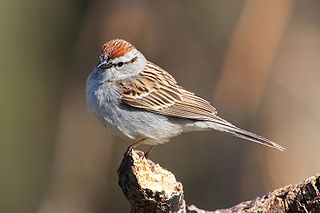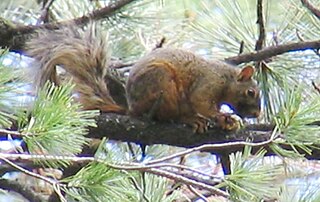
The ringtail is a mammal of the raccoon family native to arid regions of North America. It is widely distributed and well adapted to disturbed areas. It has been legally trapped for its fur. It is listed as Least Concern on the IUCN Red List. The species is known by variety of different names, such as ring-tailed cat, miner's cat, civet cat, and cacomistle, though the last of these can refer to B. sumichrasti.

The ruddy turnstone is a small cosmopolitan wading bird, one of two species of turnstone in the genus Arenaria.

The northern cardinal, known colloquially as the redbird, common cardinal, red cardinal, or just cardinal, is a bird in the genus Cardinalis. It can be found in southeastern Canada, through the eastern United States from Maine to Minnesota to Texas, New Mexico, southern Arizona, southern California, and south through Mexico, Belize, and Guatemala. It is also an introduced species in a few locations such as Bermuda and Hawaii. Its habitat includes woodlands, gardens, shrublands, and wetlands. It is the state bird of Illinois, Indiana, Kentucky, North Carolina, Ohio, Virginia, and West Virginia.

The chipping sparrow is a species of New World sparrow, a passerine bird in the family Passerellidae. It is widespread, fairly tame, and common across most of its North American range.

Antelope squirrels or antelope ground squirrels of the genus Ammospermophilus are sciurids found in the desert and dry scrub areas of the southwestern United States and northern Mexico. They are a type of ground squirrel and are able to resist hyperthermia and can survive body temperatures over 40 °C (104 °F).

The Douglas squirrel is a pine squirrel found in western North America, from the Pacific Northwest to central California, with an isolated subspecies in northern Baja California, Mexico. It is sometimes known as the chickaree or pine squirrel, although these names are also used for the American red squirrel. Variant spellings of the common name are Douglas' squirrel and Douglas's squirrel. The Native Americans of Kings River called it the "Pillillooeet", in imitation of its characteristic alarm call.

The San Joaquin antelope squirrel or Nelson's antelope squirrel, is a species of antelope squirrel, in the San Joaquin Valley of the U.S. state of California.

The fox squirrel, also known as the eastern fox squirrel or Bryant's fox squirrel, is the largest species of tree squirrel native to North America. Despite the differences in size and coloration, it is sometimes mistaken for American red squirrels or eastern gray squirrels in areas where the species co-exist.

Gambel's quail is a small ground-dwelling bird in the New World quail family. It inhabits the desert regions of Arizona, California, Colorado, New Mexico, Nevada, Utah, Texas, and Sonora; also New Mexico-border Chihuahua and the Colorado River region of Baja California. Gambel's quail is named in honor of William Gambel, a 19th-century naturalist and explorer of the Southwestern United States.

The white-tailed antelope squirrel is a diurnal species of ground squirrel, scientifically classified in the order Rodentia and family Sciuridae, found in arid regions of the southwestern United States and the Baja California Peninsula of northwestern Mexico.

Abert's squirrel or the tassel-eared squirrel is a tree squirrel in the genus Sciurus native to the southern Rocky Mountains from the United States to the northern Sierra Madre Occidental of Mexico, with concentrations found in Arizona, New Mexico, and southwestern Colorado. It is closely associated with, and largely confined to, mature ponderosa pine forests. It is named in honor of the American naturalist John James Abert; nine subspecies are recognised. It is recognizable by its tufted ears, gray color, pale underparts and rufous patch on the lower back. The squirrel feeds on the seeds and cones of the Mexican pinyon and the ponderosa pine when they are available, but will also take fungi, buds, bark, and carrion. Breeding normally occurs in summer, with a spherical nest being built high in the canopy.

The white-winged dove is a dove whose native range extends from the Southwestern United States through Mexico, Central America, and the Caribbean. They are large for doves, and can be distinguished from similar doves by the distinctive white edge on their wings. They have a blue eyering, and red eyes. The plumage is brownish-gray to gray. Juveniles are duller in color, and have brown eyes. The call is likened to English phrase "who cooks for you". There are three subspecies. It was first described by George Edwards in 1743, and given its binomial name by Linnaeus in 1756. It was moved into the genus Zenaida in 1838.

Harris's antelope squirrel is a species of rodent in the family Sciuridae. It is found in Arizona and New Mexico in the United States, and in Sonora in Mexico. They are adapted to hot weather conditions including a technique called "heat dumping". They have a wide-ranging diet, including both vegetation, insects, small rodents and carrion.
The Espíritu Santo antelope squirrel is a species of antelope squirrel in the family Sciuridae. It is endemic to Mexico, where it is known only from the island of Espíritu Santo in the Gulf of California. The species was originally described by Edward William Nelson and Edward Alphonso Goldman in 1909 as a subspecies of the white-tailed antelope squirrel, a wide-ranging species in the southwestern U.S. and Mexico. In 1938, Arthur H. Howell elevated the subspecies to full species status, on the basis of slightly larger skull proportions and the absence or reduction of the third upper premolar. Studies of DNA and chromosomes have variously suggested close relationships with Harris's antelope squirrels or other subspecies of white-tailed antelope squirrel. A 2007 comparison of DNA and morphological traits suggested the differences between Espíritu Santo squirrels and those on the Baja California peninsula and other islands were not enough to warrant distinct species but rather a subspecies of white-tailed antelope squirrels. Since 2008 the IUCN has similarly recognized the Espíritu Santo antelope squirrel as a subspecies of white-tailed antelope squirrel.

The Mexican fox squirrel is a species of tree squirrel found throughout the Sierra Madre Occidental of Mexico as far south as Jalisco — and northward into the Chiricahua Mountains of southeastern Arizona, U.S.

The spotted ground squirrel is a species of ground squirrel in the rodent family Sciuridae. It is found throughout Mexico and the central and western United States. Characterized by a white spotted back, the spotted ground squirrel is one of the smallest squirrels found in North America. They are mainly herbivorous, but also eat insects. A burrowing mammal, the spotted ground squirrel will make tunnels to store its food, as well as shelter and hibernation quarters.

The rock squirrel is a species of rodent in the family Sciuridae. It is native to Mexico and the Southwestern United States, including southern Nevada, Utah, Colorado, Arizona, New Mexico, West Texas, and the panhandle of Oklahoma.

The black jackrabbit is a species of mammal in the family Leporidae. Endemic to Mexico, its only known location is Espiritu Santo Island in the Gulf of California. The IUCN has listed this species as a "vulnerable species" because of its restricted range. This taxon is regarded by some authorities as being a subspecies of the black-tailed jackrabbit, found on the mainland of Mexico.

















